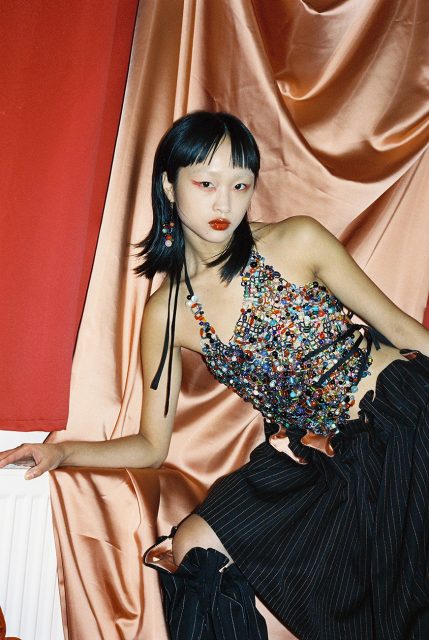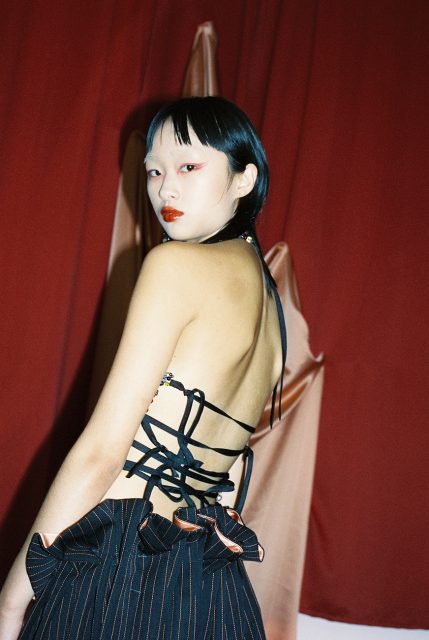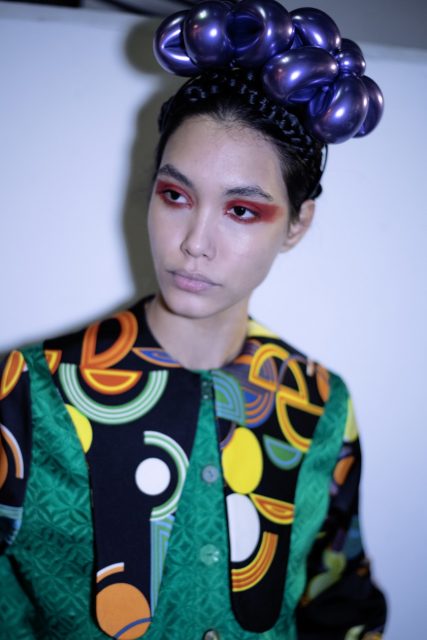2 weeks ago, Universität der Künste Berlin hosted their 2021 fashion graduate show in the grand Konzertsäle in Charlottenburg. Schau21 was presented as a short film presentation of all of the collections of this year’s eclectic and talented designers. Following the show, we caught up with one of the graduates Katharina Spitz to talk about her collection Play Harder and what the future holds.
 |
 |
Œ: You’ve just graduated from Universität der Künste, congratulations! What initially pulled you into studying fashion?
Katharina: I understand myself as a designer as well as a craftswoman. In 2013, I first entered fashion as a dressmaking apprentice at Pio O’kan Couture in Düsseldorf. After graduating in 2016, I worked at the Dutch National Opera in Amsterdam before coming to Berlin, where I studied fashion design at the Berlin University of the Arts (UdK). Then I graduated in October 2021 from the Institute for experimental Textile and Fashion Design. My passion for crafting and dressmaking remains an important aspect of my practice. So is diving deep into – for example – sociological, theoretical research and discourse, before finding ways to translate these matters into materiality and shape. Within my design process, collaboration is important. So is spontaneity as well as precision, playfulness and sincerity.
Œ: What makes your designs so unrepeatable?
Katharina: That’s always much easier to state about other people’s work! I do think it’s interesting that my designs are often only the tip of the iceberg. They are a translation of my theoretical, personal and material engagement with the topic that I am working on. Also, I do not take material for granted too easily. So I experiment a lot with not so classical garment materials. For example, I made garments from hair or porcelain, which I think is really exciting. Regarding my background in traditional tailoring, I also developed a way of combining pattern-drawing with draping techniques that I am quite excited about. And I do hope my passion for hours-long handiwork is noticeable…
 |
 |
Œ: What are your greatest inspirations?
Katharina: I am fascinated by phenomena that shape our social networks and ultimately, our position in space and time. So I guess my main inspirations are sociological phenomena as well as crafting techniques and the materialities I am working with. I am seeking ways in which my designs, performances and dressmaking can open up new perspectives of being in a world that is suffering from pollution, inequality and alienation.
To make this a bit more concrete: in my graduation project “Play Harder” I am questioning the strained relationship between work and play in modern western societies, and how it influences our access to the way we engage with each other and our material surroundings. Another example is my 2020 collection “In the Face of Loss”, where I reconsidered the relation between mortality, womanhood and crafting. Here, I was inspired by a tablecloth and its elaborate flower-pattern embroidery.
 |
 |
Œ: What inclined you to want to unravel the theoretical concept of play in your graduate collection? And what methods did you take to explore that theme?
Katharina: My “Play Harder” Graduation collection is questioning the strained relation between work and play in modern Western societies. The title is also an appeal that arose from my exploration of the subject of play concerning contemporary fashion. Fashion as part of our expressive culture is deeply rooted in play. But contemporary fashion is predominantly shaped by economic influences. In researching the concept of creational play, I was able to understand that fashion is designed for economical reasons and in turn, that undermines the playful potential of fashion. This “fashion in the sphere of work“ is resulting in a striking alienation between the people, their practices, their surroundings and their things.
The perspective of play on the other hand offers a vision in which we as people who dress, and people who design, can have a lively and intimate relationship with each other and our material surroundings. Within this project, I developed a design process that consists of play interventions. We played with each other and with garments. We tried to understand what characteristics the interaction and the garments should have to enable us to play with them.
This playful process resulted in a collection of ornamental objects – that are very impractical and useless – but very, very functional for playful interaction, resulting in a lively expressive culture. With these objects, we can create and re-create our communal expression, create and re-create our narratives. The photographs are part of one of the stories that were created in the process. There are also two more stories as part of the collection.
I came to understand play as an empowering strategy of dressing. And I think that we need empowering strategies and visions as offered by the concept of play to be able to create discourse through fashion. As a designer and craftswoman, I can’t imagine anything more desirable than participating in such a lively clothing practice.
 |
 |
Œ: What are your plans following your graduation? Are there any further collections on the way?
Katharina: I do have some projects in the waiting indeed. For example, one about garments and the act of sitting. And in my latest project, I developed this playful process as a critical tool and a very different practical approach to the design process. I experienced newfound freedom within this play-and-not-result-based design process and a special connectedness to the people I played with and the garments that were created. I believe there remain opportunities for fashion to develop in this regard, that I would like to discover further.
I am also keen to be more concrete. There are different scenarios I can imagine. Either it will be a combination of a bread-job and finding my place with the artistic/design work that I do, which could mean taking part in competitions, organising funding for future collections and trying to get my work into magazines and exhibitions. But I can also imagine working at a fashion-house, either in design or crafting. Ideally in between, because, for me, the designing and the crafting are part of the same process.
Design – Katharina Spitz
Photography – Lexi Sun
Styling – Johanna Braun
Hair and Make-Up – Una Ryu
Model – Jee Hye Lee – IZAIO MODEL MANAGEMENT






